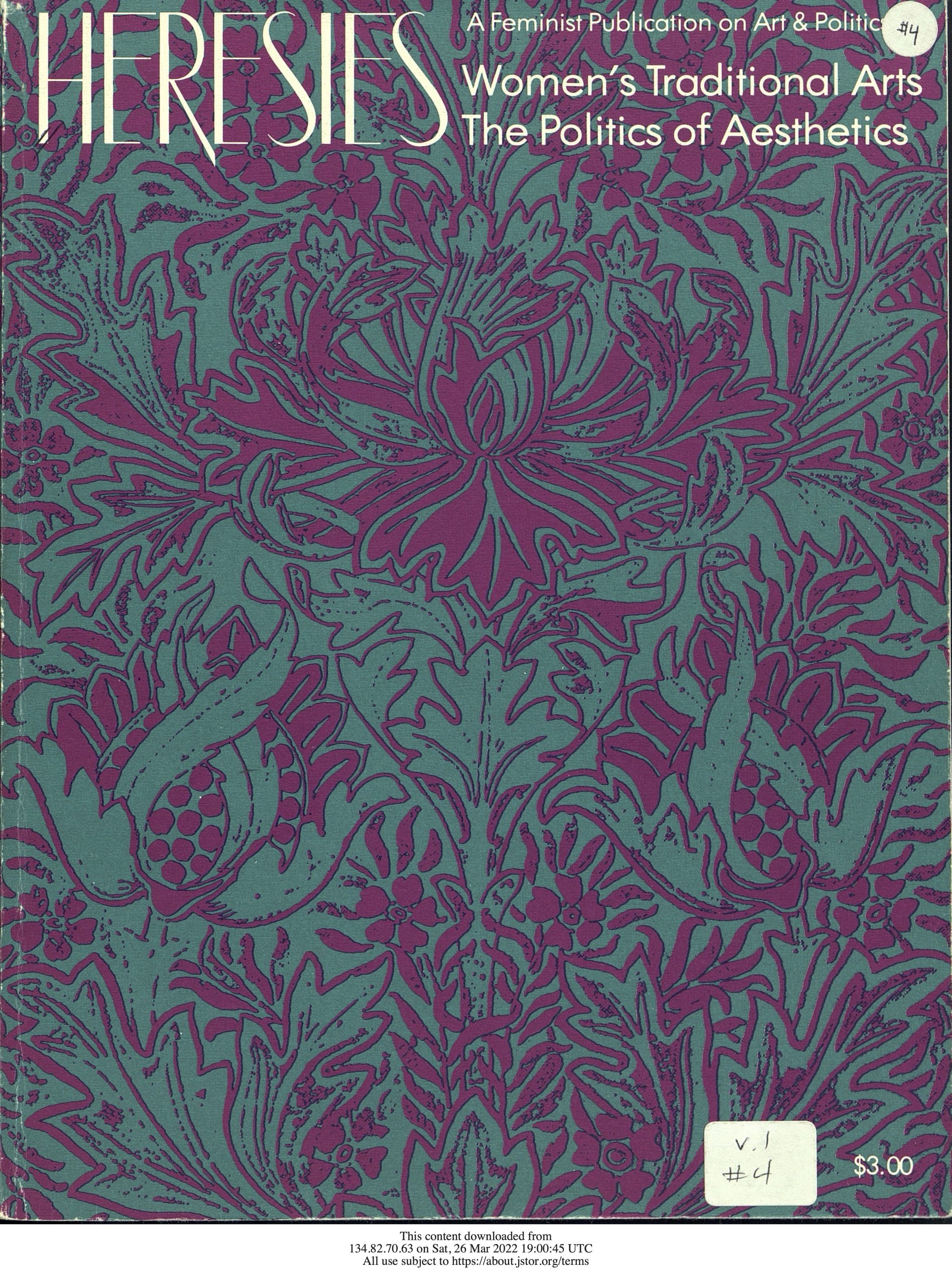Clay is a material packed with connotative richness. For the past few years, it has been my primary medium as a sculptor. The fact that many cultures traditionally have assigned clayworking to women began to intrigue me.1 Is it merely the pliability of clay or the fact that it can be worked on near the home, among children, that has, in many cases, made it a female-connected material? In terms of cross-cultural study (including both Western and non-Western societies), George Murdock and Caterina Provost’ have made one of the best attempts at examining some of the contributing factors to sexual division of labor: tendencies for males to be physically stronger than females; for females to be “burdened” by pregnancy and childcare, and thus to be assigned to soft materials and simple tools and processes and for the sex that utilizes a product to be the sex that produces it. Even though these factors are certainly worth mentioning, Murdock and Provost’s study avoids even hypothetical explanations of some of these tendencies and skirts around a major cultural component: the myth. Myth permeates the structure of all societies; entire social systems can actually be constructed around myth (modern U.S. society included) Since the majority of societies do seem to function, I find it hard to believe that they are based on pure fiction. Myth is not fiction alone. It is, in a way, a combination of fact and fiction which results in an “extended” fact (fact + story = extended fact/myth). And so when Murdock and Provost suspect at one point that masculine strength is an inadequate explanation for the division of labor, they begin to hit on something: perhaps most societies are not based on the actual physical differences between the sexes but on the myths surrounding and extending these differences.
Mythmaking seems to be an attempt to explain the unknown and to unify disparate elements in the world. Whatever its origin or purpose, the tendency nevertheless runs strong in humanity and is closely tied to symbolmaking. But while Murdock and Provost have described the denotative meanings of tasks and materials in their study, they have overlooked the connotative—the symbolic and mythical aspects to which many of these activities and objects are bound. If symbols are “storage units” (Victor Turner’s term’) which consolidate a maximum of infor mation and if, as much research has shown, a great number of things have both functional and symbolic meaning, then we can probably assume that many sexually assigned tasks are very “loaded” indeed. So maybe it’s not the actual hardness or Softness of the materials, or the ease with which they can be worked upon that determines sex divisions (though in extreme cases this might hold true), but the connotations at tached to these qualities.
I propose that the “femaleness” of clay is based on the mythology and symbology surrounding this material rather than on the material itself. This seems even more likely when one considers how complex and widespread clay—and, inseparably, earth—symbolism is. On a general level most of us have encountered a common modern earth/woman myth: “Mother Earth” is the progenitor of all living things. The earth is a womb into which seeds are placed to be nurtured; the sky (masculine) pours down its rain (semen) to produce plant growth (life) Countries (home-lands) are quite often referred to in feminine terms. The dead are returned to the earth, their origin, their “mother.” In our so- ciety, however, the origin of these myths has been lost. We no longer remember the stories on which they are based. True, we still have the Cre- ation in the Book of Genesis, but in terms of earth/woman symbology, the link is weak. Nevertheless the symbolism lingers in verbal analogy.
But on a specific level, how does an individual culture integrate myth with the operative functions of society? While researching this article I came across a society where the women are the primary clayworkers and where the female/earth symbolism and mythology are strong: the Mwambao Zaramo of Tanzania.
The Zaramo are matrilineal. Their creation myth (see Marja-Liisa Swantz') traces the origin of life to a woman, Nyalutanga, who is con- nected to the origin of everything. The name itself is related to Zaramo verbs meaning to spread about and to nouns referring to large ground mats as well as to a cucumber plant which crawls and spreads rapidly. In the myth, Nyalutanga emerges from the earth and, as her name sug gests, this first woman and the fertile earth become nearly interchangeable.
Page: 120In this story two known facts are combined, and the resulting myth presents an equation: if earth produces life and growth and if woman produces life and growth, then earth = woman. The two are mutually symbolic, and one cannot be referred to without invoking the other. Thus to be a woman is to be part of the earth and to share in its fertility, to reproduce with vinelike profusion, drawing nourishment from decaying matter (the symbolic cucumber plant flourishes on rubbish heaps). Initiated by woman, the earth became covered with people (a matrilineal line of descent).
Accordingly, that which is inextricably bound up with the earth and growth—agriculture and the cultivation of plants—is also symbolic of and therefore delegated to, woman. Women are recognized as the originators of cultivation. That Zaramo women are prominent in agricultural work is supported by Nyalutanga’s gift of the knowledge and use of plants to women, who in turn instructed the men.
The very existence and cycle of human life are dependent on woman/earth and are consolidated in and assured by Nyalutanga. Everything taught to young girls during formal instruction, maturity rites and pregnancy rites centers around this earth mother. She is the link between the earth, life and death. In agriculture, decaying life is the fertilizer for new life. In Zaramo mythology, there is a continuing theme of existing life arising out of the death of other organic matter. The earth becomes a womb where decay must take place before new life, human life, can begin. In Zaramo ritual, female and death symbolism are inseparable: if earth = woman and if the earth brings about decay and death, then woman brings about decay and death.
These life, death and earth ties constantly cross-reference themselves as well as other rituals. A Zaramo birth ritual involves performing a ritual burial after delivery. In various versions, the placenta, umbilical cord, first excrement and nail clippings are buried, returned to the earth. It is hypothesized that since the child had these things when s/he came into the world, they do not really belong to the child but rather to the true mother, the earth, to which they are returned. In another version of the birth ritual, the earth symbolism is reinforced by a reference to the death ritual. The placenta and cord are buried under the bed where the mother is resting and waiting to be washed. The bath waters are run over her body onto the ground and buried placenta below. The death ritual involves washing the corpse on a similar bed in nearly the same manner: the water is allowed to run over the body into a hole in the ground below.
The same “under the bed,” “close to the ground” ritual elements are apparent and function as female symbolism in extra-ritual activities as well. The cooking pots (symbolically female in themselves, not only in Freudian “enclosure” terms, but in terms of their reference to cooking and the sustenance of life through food, and their being made of clay) are kept under the bed—again cross-referencing life and death. It can be recognized from even these few isolated examples that female/earth symbolism permeates and reinforces Zaramo society. With such a strong cross-referencing symbol system, it becomes impossible for anyone but a woman to be involved in clayworking. If women are the source of all earth-, life- and death-related activities in every aspect of Zaramo life, then only a woman could employ a material like clay. And considering some of the uses to which the earthenware artifacts are put—pots for cooking (nourishment), vessels for washing (birth and death rituals)—it is again in keeping with the mythological structure for a woman to make these objects.
Fortunately, Zaramo mythology is easily accessible and ostensibly at work in their culture. It provides us with an opportunity to see some of the origins of sex-linked traditions in their society. Modern Western culture, on the other hand, has managed to overlay its own complex mythology with a veneer of apparent (to our eyes, at least) factuality. At this point, we are only beginning to take the first steps toward un covering these myths which form the basis of our own cultural conventions.
1. Textor, Robert B., A Cross-Cultural Summary. (New Haven, Connecticut: HRAF Press, 1967).
2. George P. Murdock and Caterina Provost, “Factors in the Division of Labor by Sex: A Cross-Cultural Analysis,” Ethnology, vol. 12, 1973, 3. Quoted in Marja-Liisa Swantz, Ritual and Symbol in Transitional Zaramo Society (Sweden: Almquist and Wiksells, 1970).
4. Swantz.
Thanks to Dr. Jehanne Teilhet for encouragement and guidance in the development of these ideas, Virginia Malsymouier is a scuhtor kiing in Neu Yoik Ciy,

